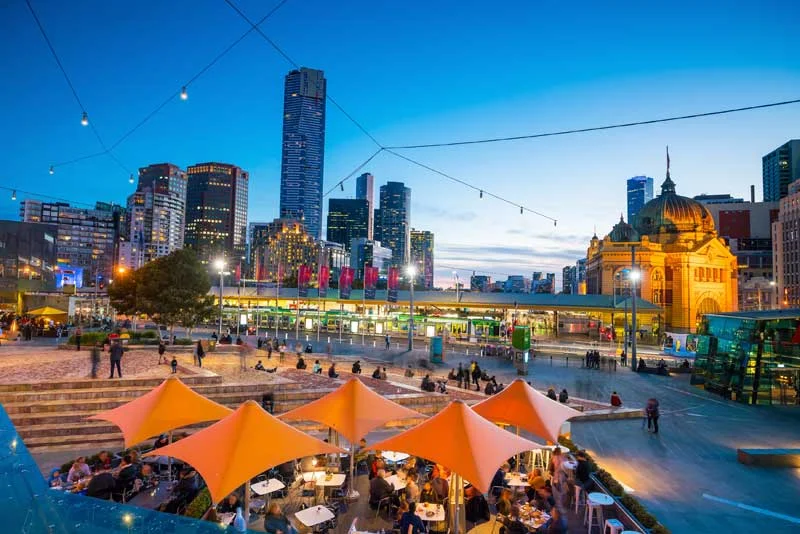
Navigating Melbourne: Public Transport Made Easy (Clickable)
Getting around Melbourne is a breeze with its well-connected and reliable public transport system. Whether you’re commuting to class, exploring the city, or visiting iconic landmarks, Melbourne’s trains, trams, buses, and taxis ensure you’ll get to your destination with ease.
Public Transport Options
Melbourne’s public transport system is among the best in Australia, offering a seamless network of trains, trams, and buses.
Trains
- Operated by Metro, Melbourne’s train network connects the city center with suburban areas.
Trams
- A defining feature of Melbourne, trams (streetcars) are a convenient and scenic way to travel, especially within the free tram zone in the central business district (CBD).
Buses
- Covering areas not serviced by trains or trams, Melbourne’s buses provide access to all corners of the city.
For regional travel beyond Melbourne, V/Line offers train and coach services to explore Victoria’s breathtaking countryside.
The myki Card: Your Ticket to Explore
Melbourne’s unified ticketing system makes travel simple with the myki card. This reusable smart card works across all trains, trams, and buses in the city and surrounding areas.
Taxis and Ride-Sharing Services
Taxis are readily available throughout Melbourne, offering flexible transport options day and night. You can:
- Book a taxi online, via phone, or through a ride-hailing app.
- Hail a taxi from the side of the road..
- Find taxis at designated ranks in busy areas like train stations and shopping centers..
Melbourne taxis are easy to recognize by their roof signs and branded exteriors. Every fare is metered, with additional charges for tolls or late-night trips. For safety, driver identification and fare details are displayed inside each vehicle.
For more information about taxis and safe travel, visit Safe Transport Victoria.
Tips for a Smooth Travel Experience
Plan your journey using the PTV Journey Planner.
Always carry your myki card, as it’s required for all train, tram, and bus travel outside the free tram zone.
Be aware of peak travel times to avoid delays.
Whether you’re heading to Swanston Institute or exploring Melbourne’s attractions, the city’s public transport system ensures your journey is stress-free and enjoyable.

Driving in Melbourne: Everything You Need to Know
Melbourne’s scenic roads and efficient transport systems make driving an enjoyable way to explore the city and the state of Victoria. Whether you’re heading to class, venturing out to the iconic Great Ocean Road, or exploring regional gems, understanding the basics of driving in Victoria will help you stay safe and compliant.
Driving in Victoria: Key Rules- Drive on the left: In Australia, you must drive on the left-hand side of the road.
- Safety first: Road laws in Victoria are strictly enforced to ensure the safety of drivers and pedestrians.
For detailed driving laws and regulations, visit the VicRoads website.
Do You Need a Driver’s Licence?
To drive in Victoria, a valid driver’s licence is essential.

If you hold an overseas licence, you may be eligible to drive for a limited period or required to transition to a Victorian licence.
If you hold an overseas licence, you may be eligible to drive for a limited period or required to transition to a Victorian licence.
Find more details, including multilingual resources, on the VicRoads licence information page.
Car Registration and Roadworthiness (Clickable)
All vehicles driven in Victoria must be:
Registered : Annual car registration is mandatory and can be renewed online. A portion of the registration fee contributes to the Transport Accident Commission (TAC), which supports individuals injured in accidents. Learn more about registration at the VicRoads registration section.
Roadworthy : Vehicles must have a valid Certificate of Roadworthiness (RWC) to ensure safety. Licensed testers issue these certificates, which are required for vehicle sales or road use.
Car Insurance
Car insurance is vital for protecting your vehicle in the event of accidents or damage.
- Choose a policy that aligns with your needs—options range from basic third-party insurance to comprehensive coverage.
- The ASIC MoneySmart website offers advice on selecting car insurance in Australia.
Navigation: Maps and Street Directories
Getting around Melbourne is easy, thanks to modern navigation tools and reliable maps:
- Use GPS-enabled systems like Google Maps or portable devices.
- Explore detailed street maps such as Melway (available in print and digital formats).
For detailed regional maps, check out the RACV VicRoads Country Street Directory of Victoria.
Toll Roads in Melbourne
Certain Melbourne roads, like CityLink and Eastlink, are tollways.
eTag
Install this device for seamless toll payments.
Passes
Purchase a pass before your trip to avoid fines.
Stay updated on toll costs and payment methods via the Linkt website.
Car Hire and Purchase in Melbourne (Clickable)
As an international student in Melbourne, having access to a car can provide flexibility and freedom to explore your surroundings. Whether you’re planning road trips, need a vehicle for errands, or want a long-term option, Melbourne has plenty of car hire and purchase options tailored to your needs.
Buying a Car in Melbourne
Owning a car can be an excellent option for students planning to stay in Melbourne long-term. Here’s how you can navigate the process:
Where to BuyLicensed Car Dealerships : These are ideal for purchasing both new and pre-owned vehicles. Dealerships are required to provide you with a warranty on certain used cars.
Private Sellers : Buying directly from individuals or auctions can be cost-effective, but requires careful research.
Top Online Platforms
What to Know
- Certificate of Roadworthiness (RWC): Any second-hand car you purchase must come with this certificate to ensure it meets safety standards.
- Ownership Transfer: After buying a car, transfer the ownership to your name within 14 days through VicRoads.
Budget Considerations
When planning your budget, remember to include:
- Registration fees
- Compulsory third-party insurance
- Fuel and maintenance costsThe RACV website offers tools to calculate running costs for different vehicles.
Key Tips for International Students
Licence Requirements : You’ll need a valid driver’s licence to hire a car. If your licence is not in English, you must carry an International Driving Permit (IDP).
Understanding Costs : Car hire prices vary by vehicle type, rental duration, and additional factors like insurance or mileage limits. Ensure all fees are clarified beforebooking.
Insurance Coverage : Most rental agreements include insurance for listed drivers. If you plan to share driving responsibilities, make sure all drivers are added to the agreement.
Road Rules and Restrictions : Familiarize yourself with Australian road rules, including driving on the left-hand side of the road. Some rental companies may have restrictions on where specific vehicles can be driven (e.g., unpaved roads).
Find more details, including multilingual resources, on the VicRoads licence information page.
Additional Resources for International Students
Multilingual Guides:
VicRoads provides videos, handbooks, and fact sheets in various languages about buying, registering, and maintaining cars.
Exploring Victoria Safely
Plan your trips with tools like Google Maps or Melway.
Exclusive Tips for Students
Join Local Groups : Many student communities on Facebook or Meetup share deals for affordable second-hand cars.
Carpooling : Reduce costs by sharing travel expenses with friends or classmates.
Seasonal Discounts : Check with car hire companies for student discounts or off-season rental deals.

Get Behind the Wheel in Melbourne
Owning or renting a car in Melbourne opens the door to endless opportunities—from exploring the iconic Great Ocean Road to visiting the picturesque Yarra Valley. As an international student, make sure you’re informed, budget-conscious, and compliant with local road rules. With a little planning, you’ll be ready to enjoy Melbourne’s stunning landscapes and vibrant culture.






















